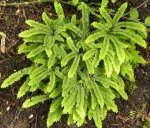 The
emergence of ferns is best to be compared with a looming up from the fog.
At first you see forms vaguely resembling ferns and bit by bit the image
becomes sharper. And at last you are sure: this is a real fern.
The
emergence of ferns is best to be compared with a looming up from the fog.
At first you see forms vaguely resembling ferns and bit by bit the image
becomes sharper. And at last you are sure: this is a real fern.
Usually a fern is defined as a cryptogam with sporangia evolving from the
leaf. This is a usable definition for living ferns but this is not always
the case for fossil ferns because for those one must rely on accidental remains.
Other characteristics of ferns can be:
- the young leaves are coiled up (mostly)
- there is no secondary wood (tree ferns evolved a different way in forming
trunks than conifers and gymnospermous trees)
- the leaves are in most cases compound and pinnate (fronds)
- aphlebiae occur: these are leaflets with an aberrant shape attached to
the base of a frond
- free gametophytes develop from the spores
According to the newest insights the horsetails and Psilotum also
belong to the ferns, but here they are not taken into consideration.
Very old plants
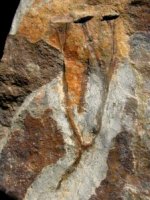 The oldest
fossils of land plants visible with the naked eye come from Ireland and date
from the Middle Silurian (425 million years). These are very small plants
up to a couple a centimeters high, called
Cooksonia. No leaves,
no flowers, no seeds, but only dichotomously forking little stems with a
sporangium on top (click on the photo on the right).
The oldest
fossils of land plants visible with the naked eye come from Ireland and date
from the Middle Silurian (425 million years). These are very small plants
up to a couple a centimeters high, called
Cooksonia. No leaves,
no flowers, no seeds, but only dichotomously forking little stems with a
sporangium on top (click on the photo on the right).
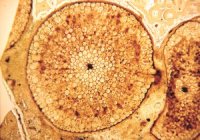 Near to the
Scottish village of Rhynie
a silicified flora has been found dating from the Lower Devonian (408 million
years), which has been preserved superbly. The picture on the left shows
a transverse section of a stem of 1.3 mm of the plant Rhynia in
which every cell is clearly visible (click). Rhynia was a cryptogam
without leaves and sized about 15 cm.
Near to the
Scottish village of Rhynie
a silicified flora has been found dating from the Lower Devonian (408 million
years), which has been preserved superbly. The picture on the left shows
a transverse section of a stem of 1.3 mm of the plant Rhynia in
which every cell is clearly visible (click). Rhynia was a cryptogam
without leaves and sized about 15 cm.
 The
group of very old plants like Cooksonia and Rhynia is often
called Rhyniophyta. It is a sister group of the clubmoss group, which developed
also very early.
The
group of very old plants like Cooksonia and Rhynia is often
called Rhyniophyta. It is a sister group of the clubmoss group, which developed
also very early.
During the Devonian (410 - 355 million years) a rather strange-looking flora
evolved from the Rhyniophyta which must have included the ancestors of the
ferns.
Gradually higher plants occurred: up to 50 cm in the Early Devonian, small
trees in the Middle Devonian and tall trees (up to 10 m) in the Late Devonian.
From the Middle Devonian on the first seed plants evolved. Real leaves appeared
(only scarcely) in the Late Devonian.
Early fernlike plants
Rhacophyton
It is not known with certainty which Devonian plants were ancestors of the
ferns. Several groups are mentioned but there is no common assent about it.
Many of those ancient plants share characteristics with ferns but they have
also characteristics of other groups, e.g. the conifers, like the presence
of secondary wood.
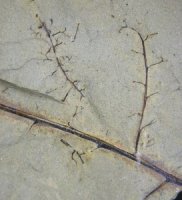 A plant
apparently closely related to the ferns is Rhacophyton
condrusorum, occurring among other places in Belgium.
A plant
apparently closely related to the ferns is Rhacophyton
condrusorum, occurring among other places in Belgium.
This plant had a branching system with the main axis and the secondary branches
lying in one plane and the further branchings being three-dimensional (click
on the picture on the left). The fact that the main axis and the secondary
branches were situated in one plane, is interpreted as a preliminary stage
in the formation of leaves: in earlier plants all axes formed a three-dimensional
system.
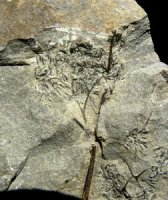
The sporangia were growing in clusters (click on the photo on the right).
At the base of a side branch a deeply divided leaflet was attached, called
aphlebia.
Rhacophyton may probably be considered as a stage in evolution less
far evolved than the oldest real ferns. It is positively uncertain that this
is a real intermediary stage in the evolution of ferns.
A theory
In 1930 Zimmerman launched a theory in which he described a number of
evolutionary processes (among others) leading to the development of fernlike
leaves.
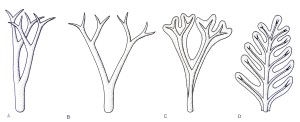
One of the processes is called planation (B). With this, branchings,
being part of a threedimensional system (like in Rhacophyton), are
becoming coplanar. Possible advantage could be the fact that more light can
be captured.
Another process is webbing (C) whereby branchings get connected by cell tissue.
This leads to the development of leaves.
When the side branches are placed regularly along the sides of an axis, it
is imaginable that a fernlike leaf comes into existence (D).
Of course this is only a theory, but many of the intermediate phases have
been found indeed. It is called 'telome theory', telomes being the ultimate
branches.
Plants from the order of the Zygopteridales are
commonly included into the early fernlike plants but some consider them to
be true ferns. They have complex, paired leaves and branchings up to the
fourth order (four times branched). They appeared at the end of the Devonian
(340 million years) and died out in the course of the Permian (200 - 250
milllion years).
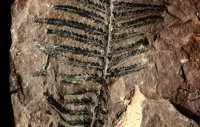 The
group includes the genus Alloiopteris (picture on the left) and the
species Nemejcopteris feminaeformis (right).
The
group includes the genus Alloiopteris (picture on the left) and the
species Nemejcopteris feminaeformis (right).
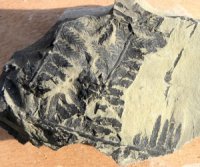
The aphlebiae in this group are interesting because they are branched many
times and because they are threedimensional in some genera and planated in
other ones.
The plants in this group had true leaves but these were still small. It is
thought that they were growing mainly in somewhat dryer places with plenty
of light in the coal swamps.
The groups described below contain in most cases also still living species.
Taylor et al divides them in Marattiales (Marattia-like ferns),
Ophioglossales (adders's tongue-like ferns) and leptosporangiate ferns. The
extant ferns of the first group can be seen as living fossils. A vast majority
of the recent ferns belongs to the third group.
Botanists working on living material, are often using different
classifications.
Ferns and seed ferns
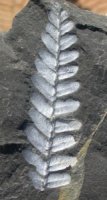 At first sight
the coal flora of the Upper Carboniferous seems to be very rich in ferns.
At first sight
the coal flora of the Upper Carboniferous seems to be very rich in ferns.
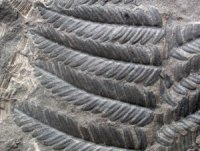 This is, however,
appearance, because most of the fernlike leaves come from gymnospermous plants
(photo on the left). These are indicated with the confusing term
'seed fern'. They are, after all, not ferns but gymnosperms. The majority
of the many fernlike fossils in the Upper Carboniferous originate from seed
ferns. Only in the uppermost part of the Upper Carboniferous the true ferns
become dominant. A well-known example of a true fern is Pecopteris
(photo on the right).
This is, however,
appearance, because most of the fernlike leaves come from gymnospermous plants
(photo on the left). These are indicated with the confusing term
'seed fern'. They are, after all, not ferns but gymnosperms. The majority
of the many fernlike fossils in the Upper Carboniferous originate from seed
ferns. Only in the uppermost part of the Upper Carboniferous the true ferns
become dominant. A well-known example of a true fern is Pecopteris
(photo on the right).
Of many leaf fossils from the Carboniferous it is yet unknown if they come
from a fern or a seed fern. These specimens are classified in an artificial
genus on the ground of resemblance of form and venation. An example of such
a 'form genus' is Sphenopteris (photo below). As soon as such a leaf
is found with sporangia or with an attached seed, it is placed in a natural
genus (with a different genus name). Thus a form genus is a sort of bin for
forms which are not yet fully understood.